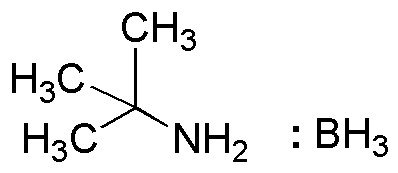Borane tert-butylamine complex is widely utilized in research focused on:
- Organic Synthesis: This complex serves as a reliable reducing agent in organic reactions, enabling the conversion of various functional groups, such as ketones and aldehydes, into alcohols. This is particularly beneficial for chemists looking to streamline synthesis processes.
- Hydroboration Reactions: It is commonly used in hydroboration, a method that allows for the addition of boron to alkenes, facilitating the formation of organoboranes. This is crucial for the production of complex organic molecules in pharmaceuticals and agrochemicals.
- Polymer Chemistry: The complex acts as a catalyst in the polymerization of certain monomers, enhancing the efficiency and control over the molecular weight of the resulting polymers, which is essential in the development of advanced materials.
- Hydrogen Storage: Researchers are exploring its potential in hydrogen storage systems, where it can help in the safe and efficient storage of hydrogen, a key component in clean energy technologies.
- Analytical Chemistry: It is utilized in various analytical techniques, including NMR spectroscopy, to enhance signal detection and improve the accuracy of measurements in complex mixtures.
General Information
Properties
Safety and Regulations
Applications
Borane tert-butylamine complex is widely utilized in research focused on:
- Organic Synthesis: This complex serves as a reliable reducing agent in organic reactions, enabling the conversion of various functional groups, such as ketones and aldehydes, into alcohols. This is particularly beneficial for chemists looking to streamline synthesis processes.
- Hydroboration Reactions: It is commonly used in hydroboration, a method that allows for the addition of boron to alkenes, facilitating the formation of organoboranes. This is crucial for the production of complex organic molecules in pharmaceuticals and agrochemicals.
- Polymer Chemistry: The complex acts as a catalyst in the polymerization of certain monomers, enhancing the efficiency and control over the molecular weight of the resulting polymers, which is essential in the development of advanced materials.
- Hydrogen Storage: Researchers are exploring its potential in hydrogen storage systems, where it can help in the safe and efficient storage of hydrogen, a key component in clean energy technologies.
- Analytical Chemistry: It is utilized in various analytical techniques, including NMR spectroscopy, to enhance signal detection and improve the accuracy of measurements in complex mixtures.
Documents
Safety Data Sheets (SDS)
The SDS provides comprehensive safety information on handling, storage, and disposal of the product.
Product Specification (PS)
The PS provides a comprehensive breakdown of the product’s properties, including chemical composition, physical state, purity, and storage requirements. It also details acceptable quality ranges and the product's intended applications.
Certificates of Analysis (COA)
Search for Certificates of Analysis (COA) by entering the products Lot Number. Lot and Batch Numbers can be found on a product’s label following the words ‘Lot’ or ‘Batch’.
*Catalog Number
*Lot Number
Certificates Of Origin (COO)
This COO confirms the country where the product was manufactured, and also details the materials and components used in it and whether it is derived from natural, synthetic, or other specific sources. This certificate may be required for customs, trade, and regulatory compliance.
*Catalog Number
*Lot Number
Safety Data Sheets (SDS)
The SDS provides comprehensive safety information on handling, storage, and disposal of the product.
DownloadProduct Specification (PS)
The PS provides a comprehensive breakdown of the product’s properties, including chemical composition, physical state, purity, and storage requirements. It also details acceptable quality ranges and the product's intended applications.
DownloadCertificates of Analysis (COA)
Search for Certificates of Analysis (COA) by entering the products Lot Number. Lot and Batch Numbers can be found on a product’s label following the words ‘Lot’ or ‘Batch’.
*Catalog Number
*Lot Number
Certificates Of Origin (COO)
This COO confirms the country where the product was manufactured, and also details the materials and components used in it and whether it is derived from natural, synthetic, or other specific sources. This certificate may be required for customs, trade, and regulatory compliance.

